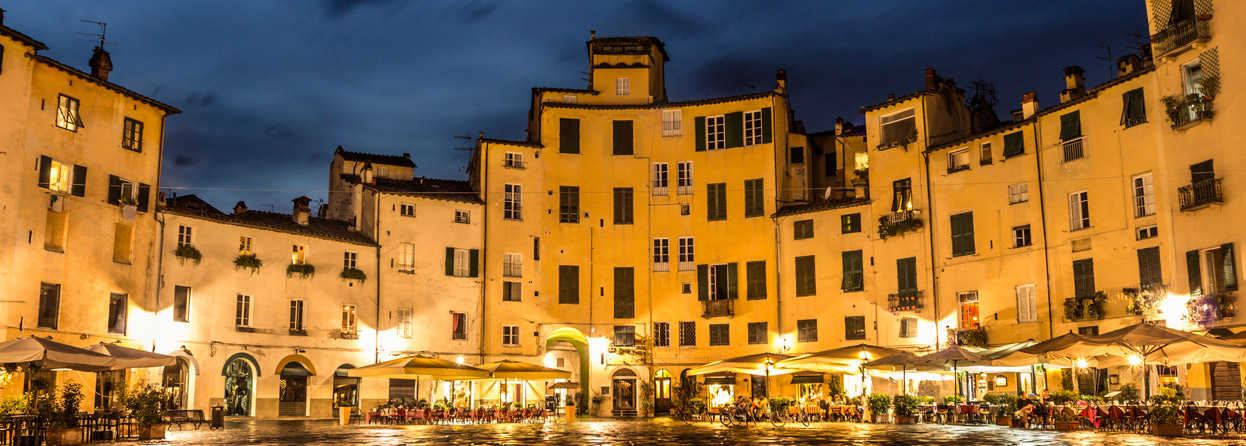
Founded as a Ligurian settlement, according to some historians, while others think that has Etruscan origins and become a Roman colony in 180 BC, in the 6th century Lucca became the capital of the Lombard duchy of the Tuscia and developed later during the 12th century as a Municipality and then as a Republic.
Roman colony since 180 BC, Lucca has preserved many of its typical characteristics of the ancient times. The amphitheatre that still preserves its peculiar form of closed elliptical square; the forum, located in the current San Michele Square dominated by the homonymous Romanesque church that strongly reminds of Greek art in many architectural components. But the clearest Roman track is in the historical streets of the centre that reflect the orthogonality of the Roman settlement based on the cardo and decumanus, corresponding to the current via Fillungo-Cenami and San Paolino-Rome-Santa Croce. To the Roman age also belong the first walls that surrounded a squared area where, with the passing of time, arose the centre of the political power (the current Ducal Palace) and the religious centre. In 55 BC Lucca was the scene of a meeting for the first triumvirate among Caio Giulio Cesare, Gneo Pompeo Magno and Marco Licinio Crasso where Cesare obtained the extension for a further five-year period of the proconsul in the Gaul.
Occupied by the Goths in 400 and by the Byzantines in the following century, the history of Lucca was characterized by the fact of being among the most important capitals of the Lombard kingdom. We remember in fact Desire third Count of Lucca and elected “Rex Langobardorum” in 756 and the successors Allone, fourth Count and Duke of Pisa and Wicheramo, fifth Count, who became a vassal of Charlemagne. Thanks to the presence of the Holy Face in the church of S. Martin, Lucca became a main stop-over in the pilgrimage from Canterbury to Rome along the Via Francigena, one of the most important roads of the Middle Ages. Despite this, few traces remain of this historical period. In 773 the Lombard dominion of Lucca fell, and the Carolingian domination began, thanks to the defeat of the Dukes of Lucca at the hands of Charlemagne. During this period the city strengthened its important position conquered in the Lombard age, improving its condition thanks to the trade activity and textile production, by which it became famous all over Europe. The textile production was the beginning of the economic growth of Lucca and, thanks to silk manufacturing, Lucca became more and more important on the European markets. The very high quality of the product was due to delicacy of materials and beauty of colours. In particular, in the Middle Ages the city grew a lot in relationship to the old Via Francigena which Lucca was an important stop-over of at religious level for the presence of the Holy Face, a venerated wooden corpus of a crucifix that is in the Cathedral of Lucca. In the itinerary of Sigeric, Archbishop of Canterbury, the city represented the 26th stop-over (Mansio).
Despite the constant vicissitudes related to the struggles between Guelphs and Ghibellines, in the fourteenth century Lucca became one of the most important cities of the Italian Middle Ages. The Lord Castruccio Castracani degli Antelminelli, a noble Ghibelline of great political and military capacity, was able to make it unique antagonist against the expansion of Florence bringing it to victory (1325) in the battle of Altopascio where he defeated the strong Florentine army chasing it up to the walls of Florence. After Castruccio’s death, the city lived a period of anarchy and was subject to the domination of the Visconti and later of the dictatorship by Giovanni Dell’Agnello, doge of the Republic of Pisa. Regained its freedom in 1370 through the intervention of the Emperor Charles IV, Lucca founded a republican government, and with a shrewd foreign policy obtained again a considerable reputation in Europe thanks to its bankers and the silk trade.” Il 27 Marzo 1370 Messer Guido da Bologna cardinale, lasciò Lucca libera ai lucchesi e l’Agosta, grande fortezza (eretta de Castruccio) si gettò in terra tutta.” [Diario dei Monaldi], Milan, 1845, p. 433. The Emperor Charles IV granted the city the opportunity to adopt a ‘studium’ generale, but a real university in Lucca was not built before 1787.
Aside from a short period of lordship like that of Paolo Guinigi, Lucca remained an independent republic until 1799, the year of its final fall at the hands of the Austrians. On June 23, 1805 upon request of the senate of Lucca, was founded the Principality of Lucca and Piombino, given to Napoleon’s sister, Elisa Bonaparte and her husband Felix Baciocchi.
During the Congress of Vienna it was decided to create the Duchy of Lucca. On May 10, 1815 took over as regent Maria Luisa of Bourbon-Spain, whom Charles Louis of Bourbon succeeded from 1824 to 1847. In 1847 Lucca became part of the Grand Duchy of Tuscany. In 1860 it was annexed to the kingdom of Sardinia.
Dante’s Divine Comedy includes many references to the great feudal families who had huge jurisdictions with administrative and judicial rights. Dante spent some of his exile in Lucca.